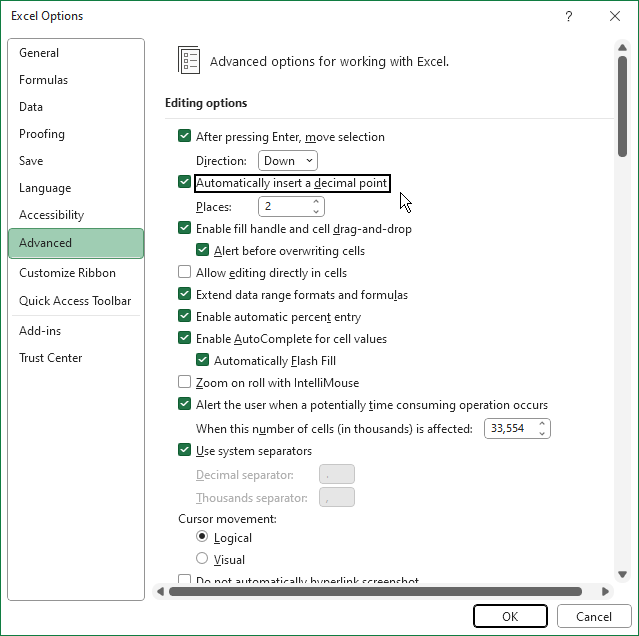Please Note: This article is written for users of the following Microsoft Excel versions: 2007, 2010, 2013, 2016, 2019, 2021, and Excel in Microsoft 365. If you are using an earlier version (Excel 2003 or earlier), this tip may not work for you. For a version of this tip written specifically for earlier versions of Excel, click here: Fixing the Decimal Point.
Written by Allen Wyatt (last updated February 4, 2023)
This tip applies to Excel 2007, 2010, 2013, 2016, 2019, 2021, and Excel in Microsoft 365
Most electronic calculators have an option that allows you to specify a fixed location for a decimal point. This comes in real handy when you are working with dollars and cents, for instance. With the decimal point fixed at two places, you can enter "213" and have the calculator translate it as "2.13". Likewise, if you enter "2", the calculator translates it as "0.02".
Excel has a feature that allows you to do the same thing. To fix the number of decimal places assumed when inputting information, follow these steps:

Figure 1. The advanced options of the Excel Options dialog box.
Remember that this control only affects any new values that you enter into a cell. It does not affect any values entered previously. Thus, if a cell already contains the value 1.2345, then changing the setting to 2 decimal places will not change the value to 1.23 or 123.45.
It also only affects new values entered where you don't include a decimal point. Thus, if you have the decimal places set to 2 and you enter "1.2345" (with the decimal point), then the value entered will include the four decimal places.
ExcelTips is your source for cost-effective Microsoft Excel training. This tip (7565) applies to Microsoft Excel 2007, 2010, 2013, 2016, 2019, 2021, and Excel in Microsoft 365. You can find a version of this tip for the older menu interface of Excel here: Fixing the Decimal Point.

Program Successfully in Excel! This guide will provide you with all the information you need to automate any task in Excel and save time and effort. Learn how to extend Excel's functionality with VBA to create solutions not possible with the standard features. Includes latest information for Excel 2024 and Microsoft 365. Check out Mastering Excel VBA Programming today!
Tired of the same old boring Excel look? You can add some life to your worksheets by introducing some animation. Here's ...
Discover MoreGridlines are very helpful in seeing where cells are located on the screen. You are not limited to black gridlines; ...
Discover MoreThe Formula bar is used to display the formula that appears in a cell. You may want to modify how the Formula bar is ...
Discover MoreFREE SERVICE: Get tips like this every week in ExcelTips, a free productivity newsletter. Enter your address and click "Subscribe."
2023-02-04 11:33:13
J. Woolley
My Excel Toolbox includes the FixedDecimal macro to enable or disable fixed decimal data entry. You can easily adjust the fixed decimal place (positive or negative) assigned to numbers entered without a decimal point.
My Excel Toolbox also includes the following function to return the fixed number of decimal places, or FALSE if that feature is disabled:
=FixedDecimalPlaces()
See https://sites.google.com/view/MyExcelToolbox/
For related discussion, see https://excelribbon.tips.net/T007563_Entered_Values_are_Divided_by_100.html
Got a version of Excel that uses the ribbon interface (Excel 2007 or later)? This site is for you! If you use an earlier version of Excel, visit our ExcelTips site focusing on the menu interface.
FREE SERVICE: Get tips like this every week in ExcelTips, a free productivity newsletter. Enter your address and click "Subscribe."
Copyright © 2025 Sharon Parq Associates, Inc.
Comments